Sky High
Bassick High School and SHU are encouraging students to get their heads in the clouds.
From the spring 2023 issue of the Sacred Heart University Magazine
by Kelly De La Rocha
Tiany Perez sits in the fuselage of a partially built Vans RV12iS aircraft, securing bundles of multicolored wires. The high school senior works with
confidence, hands steady despite the staccato rhythm of rivet guns echoing through Bassick High School’s expansive workshop.
But the rivet guns aren’t the only thing Perez blocks out to focus on the task at hand. Beyond the shop’s brick walls sprawls Bridgeport–– Connecticut’s most populous city––where nearly a quarter of residents live in poverty. The majority of Perez’s classmates are part of that struggling population. Many come from single-parent homes. Some call a local rescue mission home. According to Principal Dr. Joseph Raiola, close to 80% of Bassick’s students qualify for free or reduced-price school meals.
“It’s very difficult for these kids,” says Steve Blume, Bassick’s technology teacher, who oversees the shop where Perez is hard at work. “Sometimes they come just to get breakfast and lunch. “It’s difficult even for them to get to school,” he adds, noting the school provides only limited busing––an additional barrier to attendance.
All in all, about half of the 1,000-student population leaves during a typical school year, breeding an uncertainty that makes it difficult to connect with students––even the ones who stay––in any meaningful way.
Here in the shop, however, a unique project is underway to change that.
Sacred Heart University electrical engineering major Anthony Matos ’24 is one of two SHU interns mentoring Bassick students on a project to build a pair of two-seat airplanes from the ground up, taking on everything from
interpreting blueprints to assembling the fuselage to wiring cockpit controls. If the planes pass muster with the Federal Aviation Administration, students will have an opportunity to take to the skies in them.
Matos watches Perez as she tightens cable ties around wire bundles in the plane’s cockpit. “Tiany’s always in the fuselage doing some type of work,” he says while consulting a blueprint of the project’s present phase. “She is always the one getting down there and doing the work no one else wants to do.”
The two students, years apart academically, are working in tandem toward
a goal that reaches far beyond building a functional aircraft. In conjunction with a cadre of fellow students, teachers and aviation industry professionals, they’re building a runway to the future.
Despite a growing demand for workers with technical skills, a hands-on course of study like this one is rarely offered at a cash-strapped inner-
city school like Bassick. Aaron Hollander, chairman, CEO and founder of First Aviation Services, led the push to bring the program to the high school. Partnering with Tango Flight, an educational nonprofit corporation that aims to inspire the next generation of engineers, pilots, aviation mechanics and technicians, the project’s aim is not just to help students learn marketable skills, but also to give them a chance to interact with positive role models. Aviation industry professionals volunteer daily in that
capacity.
SHU students were brought on board for that purpose as well, an arrangement orchestrated with the help of Rick Robustelli, executive in residence and an instructor at SHU’s Jack Welch College of Business & Technology. As mentors, the students provide real-time information about what college is like, helping to demystify an educational path Bassick attendees may not have previously considered.
Bassick’s present graduation rate is just 65%. Of that already diminished number, only about half go on to any form of continuing education (about 10% to a four-year degree program, roughly 40% to a two-year program) while the rest end any form of formal education right there.
Working on the aviation project with positive role models illuminates other potential pathways.
Under the watchful eyes of their mentors, the students build bulkheads and frame an airplane tail. As viable airplanes slowly take shape, they realize they can do what may have once seemed impossible, and that’s empowering.
“These high school kids came here and couldn’t read a ruler. Now they can read blueprints,” Blume says. “They’re very difficult to understand––there are 47 books, at least 10 pages each, and on each page there’s got to be 50 things that have to be checked off, in order, as you do them––and they’re doing it.
“I’ve got kids who are out there in college because of this,” Blume adds. “They’re going to be employed in the aviation industry somewhere. [That would never have happened] without this.”
“I do believe if we say to our kids, ‘You can do it,’ and show them how to do it, they will do it. They do do it. There is no question about that,” says Raiola, who notes he’s seen students become more engaged, motivated to come to class, driven to graduate and eager to investigate careers associated with aviation. Perez is a perfect example of that, although she admits it took her a while to find that drive.
“At first I was lazy with it. I wouldn’t come to class much. I would skip it. And then, I don’t know what happened. I started coming more and actually participating, and I fell in love with it,” she says. “Since I found this, I found my passion. I’m going to keep doing this into the future.”
Jamal Diaz has a similar story.
“Last year I would not have thought I’d end up here, working on wings, engines and windows,” the high school senior recalls. “At first I was iffy about it, but now I’m used to the environment and actually getting my hands dirty and stuff like that. I enjoy it a lot. It’s something I would definitely consider after I graduate.”
The program is also an asset to SHU’s student interns, who are gaining technical and leadership skills. Luke Bellacini ’25, a sophomore majoring in electrical and computer engineering, says the internship’s hands-on component has reinforced his conviction that he has chosen the correct field of study.
“In class, you go through math and physics, the theoretical aspects and everything, but this is more real-life application,” he explains. “I’m getting experience working with the tools that I’ll actually need to assemble the plane and assemble ideas and actually bringing them to life.”
Experiential, project-based learning is widely employed in SHU’s engineering program. Students build drones as part of the regular curriculum, but this aviation project is the first opportunity they’ve had to work on such a large scale, says Dr. Tolga Kaya, SHU’s director of engineering.
“It’s something that has a wow factor. It gives you accountability, reliability, all sorts of engineering perspectives,” explains Kaya, who was
instrumental in placing Matos and Bellacini in the internship. “These planes are going to be FAA approved, and they will fly, so it’s not a joke.”
The aviation industry professionals who work with the students ensure the planes are built to strict standards. In the process, they teach marketable technical skills, as well as effective communication and collaboration techniques.
“The mentors are not just here to tell the kids what to do,” Raiola notes. “They’re working side-by-side with the students, and as a result they’re having dialogue about life, careers, next steps. They’re serving not only as a mentor to build an airplane, but a mentor for life.”
David Paqua, a licensed aircraft mechanic and owner of Franklin Glass and Aluminum in Stamford, has built a number of airplanes from scratch. He’s been a volunteer for the aviation program since October 2021. Between fielding questions about airplane assembly, he discusses aviation-related job possibilities with the students.
“From mechanical work, you can go up to management. You can do pilot stuff. You can really do whatever you want. You just have to get your feet wet and find out what you like,” he advises.
Paul Zielinski, a Delta Airlines pilot volunteering with the project, has had plenty of experience flying planes, but this is his first attempt at building one. He says he tries to stay one step ahead of the students so he can guide them through each phase of the project.
“It’s been great. They’re really eager to learn,” he says. “They like the hands-on parts of building. As the airplane gets built, they can see the
progress and what it might eventually be. They get real excited about that.”
SHU interns serve as a bridge between the aviation industry professionals and the Bassick students. The high schoolers find Matos and Bellacini easy to relate to, in part because the college students are close to their age.
Bellacini’s role in the aviation project is to explain tasks to the younger students and oversee their work. But when he talks about the airplane-
building process, he’s also quick to highlight the relationship-building that occurs.
“It’s a blast talking to them. They’ll ask me questions like, ‘What’s it like to be an engineer in college? What kinds of classes do I have to take?’ One student was even asking me about a particular class he could take next semester before he graduates,” the North Reading, MA, native recounts. “I’m very jealous my high school didn’t have something like this. Just being here puts a smile on my face.”
Matos, a SHU junior from Brooklyn, NY, says he’s seen the younger students grow during their short time together in the program. He singles out senior Amory Beckford, who is busy securing a drainage tube to a plane’s engine mount.
“I was kind of anxious and nervous at first because I did not want to fail or mess up,” Beckford, pausing from his work, recounts. “I’m feeling more confident now. I’m a supervisor.”
Beckford initially had aspirations of becoming an auto mechanic or a software engineer, but once introduced to the aviation program, he began considering a degree in electrical engineering. He turns to Matos for advice.
“He asked me about the classes: ‘Are they hard?’” Matos recounts. “I'm not gonna give it to him sweet. I tell him, ‘Listen, it requires work.’”
As Matos watches Beckford work, it’s obvious the SHU student takes pride in his leadership role. The mentoring he and Bellacini provide is an example of the community service component regularly incorporated into SHU’s engineering curriculum. Kaya says it’s an invaluable part of the experience.
“I believe that it makes them better engineers when they feel like there is meaning to what they are doing,” he explains. “You can see how excited they are. It’s not just the program itself, but also they feel like they are making a difference in the community.”
The benefit is reciprocal, Matos points out, with a nod to some of his young charges, who are riveting an airplane tailpiece like seasoned pros, the percussion of their rivet guns echoing through the shop like the unexpected sound of opportunity.
“I see how I could have been as a high school student––more driven like they are. It definitely drives me,” he says. “They’re four years younger than me, three years younger than me. To see them be driven like this makes me want to be like them.”
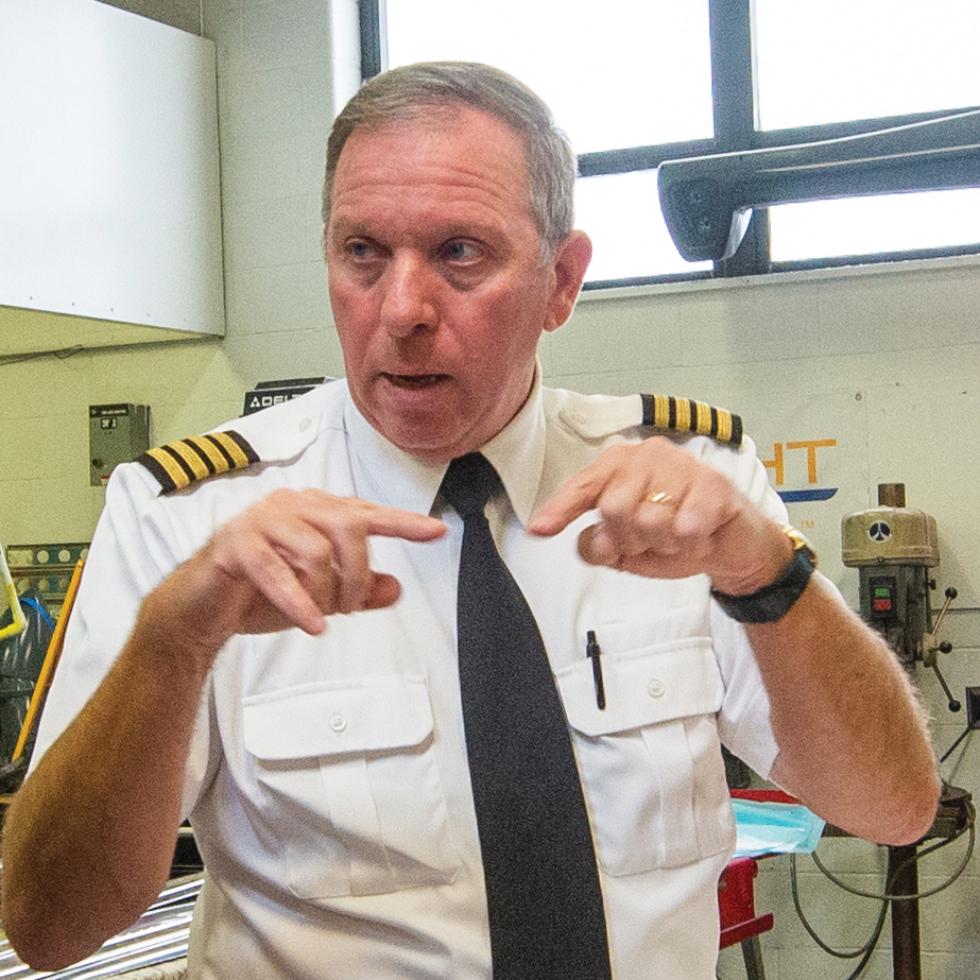
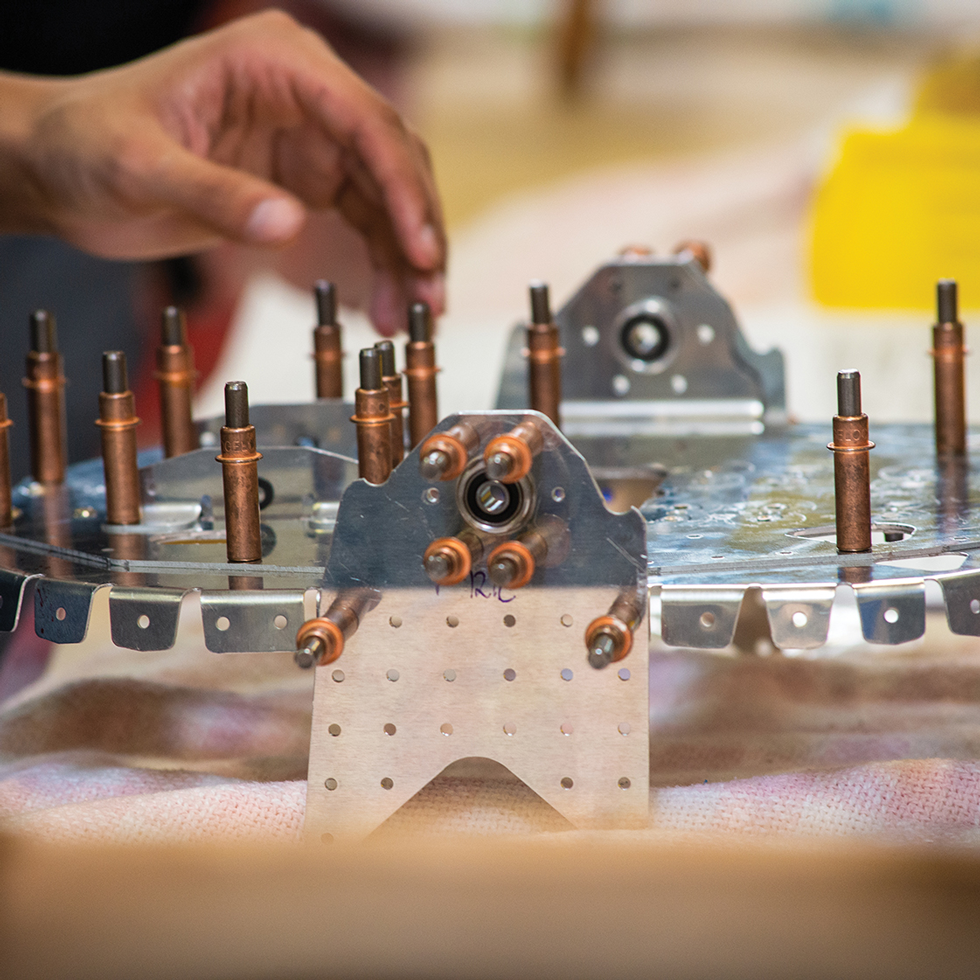
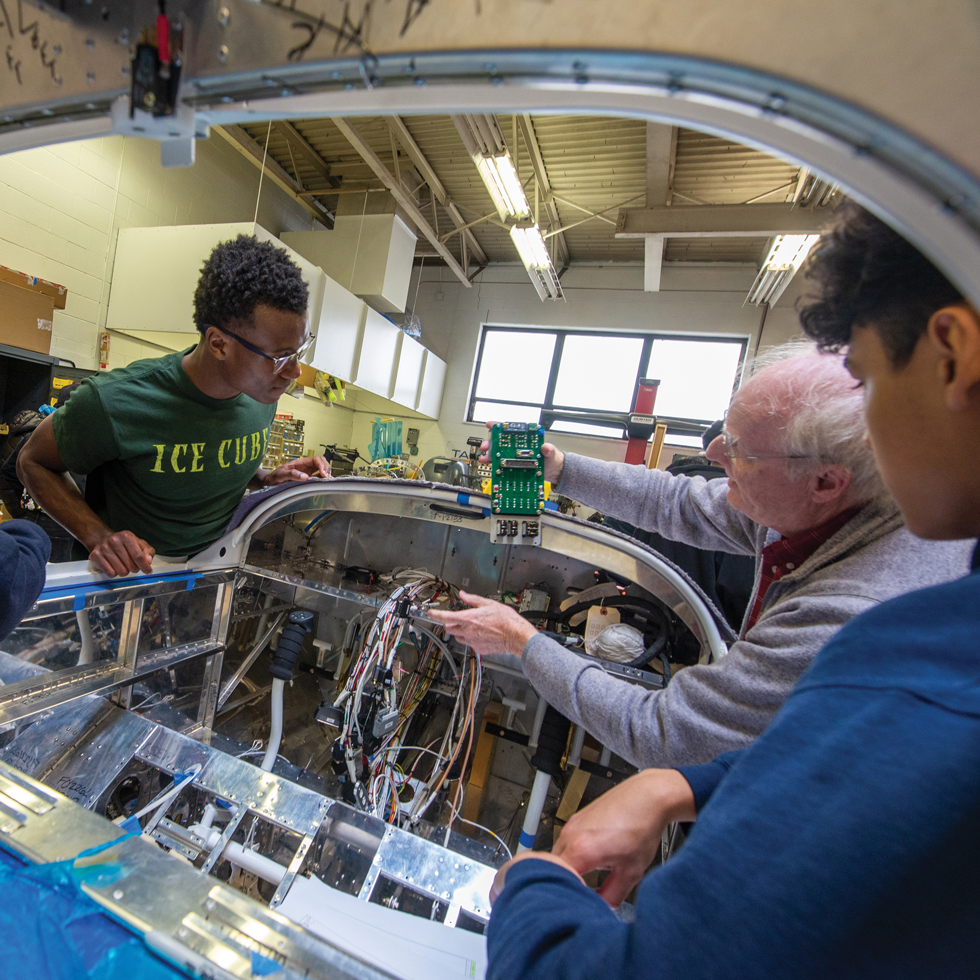
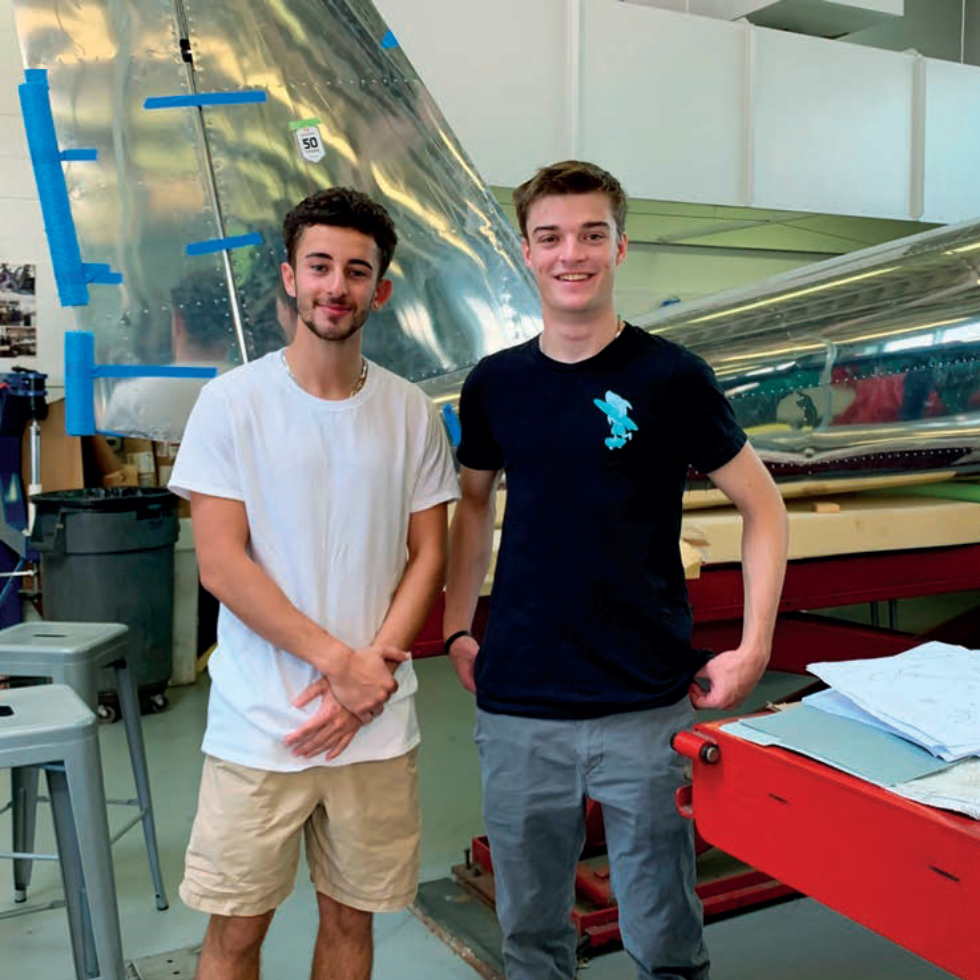
Photogallery

Capt. Paul Zielinski helps connect the dots between the mechanics and physics of flight.
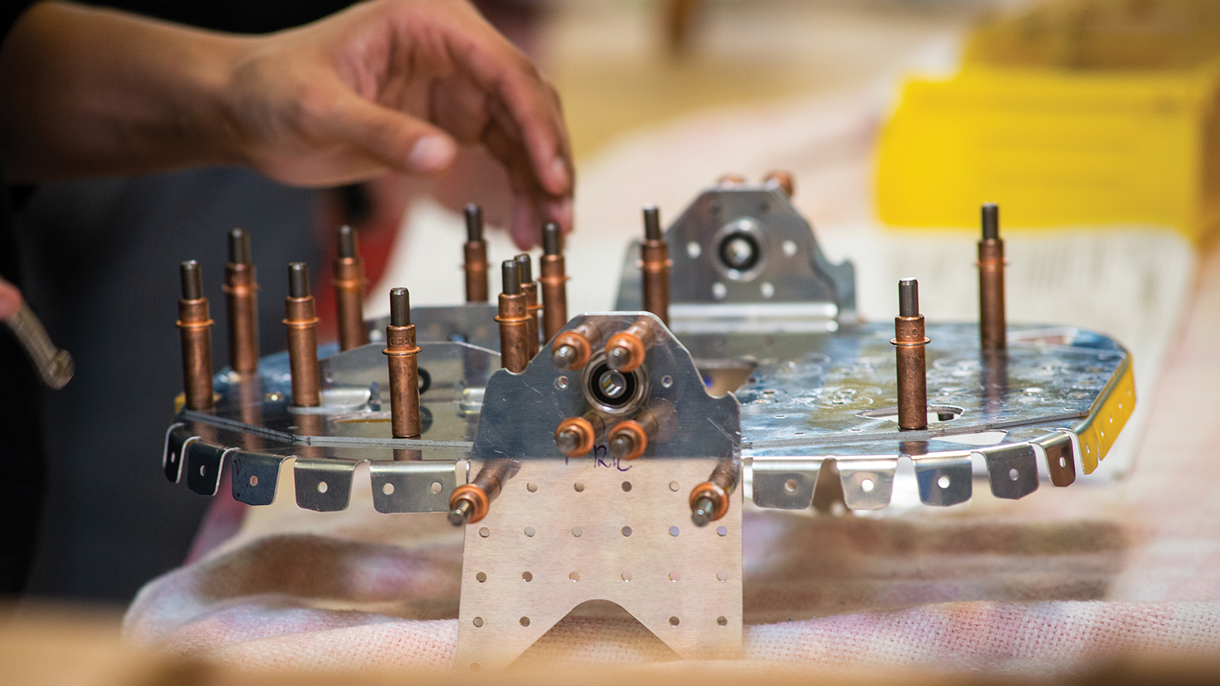
Student working on a part of the airplane
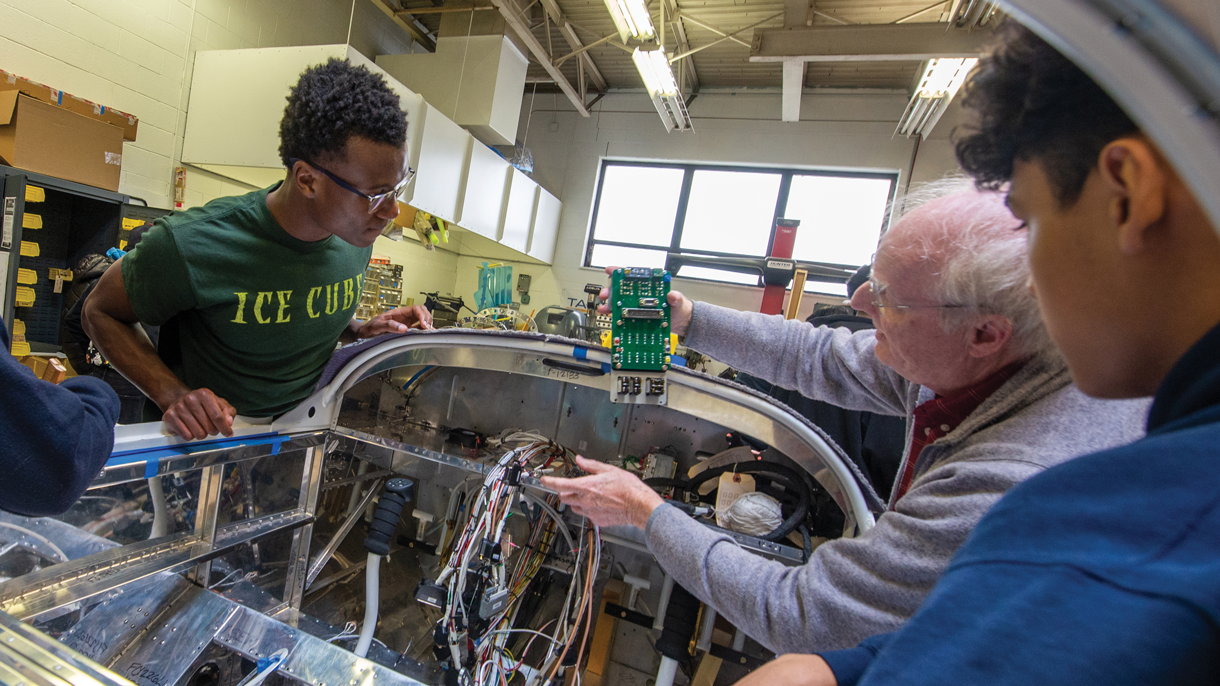
Avionics volunteer Andrew Graham guides students in a project with high ambitions
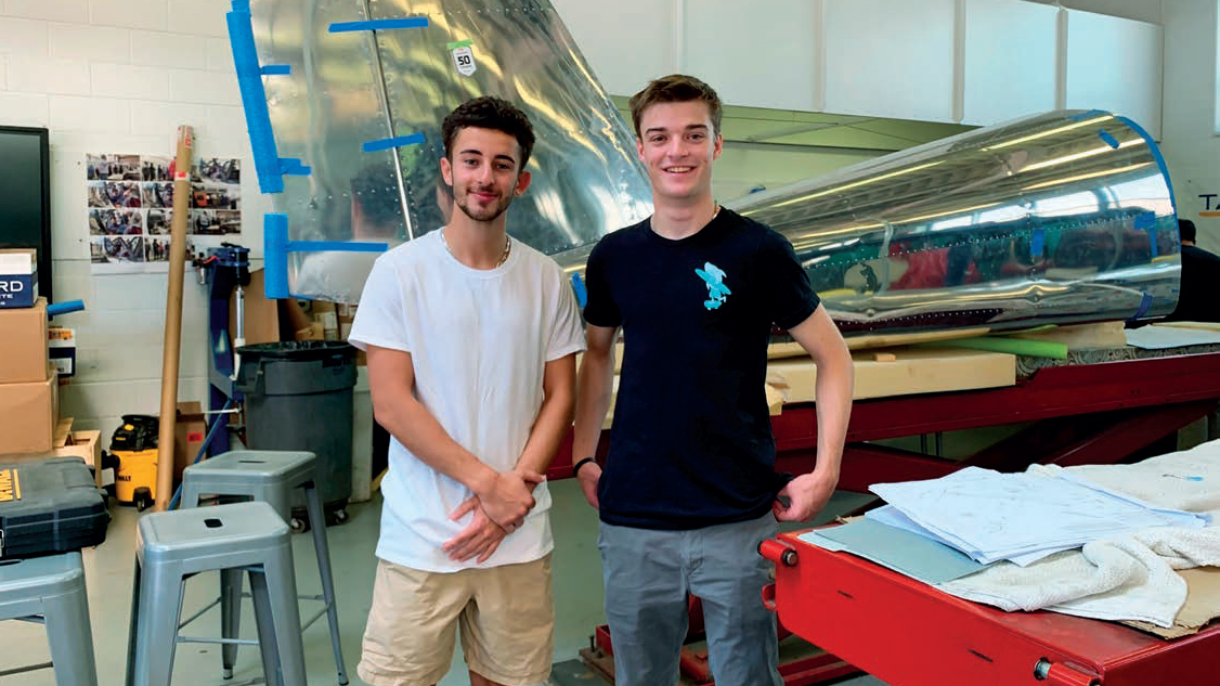
Students, Mentors & Engineers Anthony Matos '24 & Luke Bellacini '25